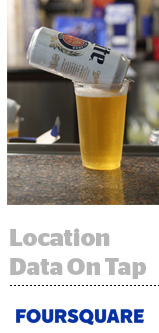
MillerCoors doesn’t have the opportunity to collect much first-party data: Most of its sales come through independently-owned convenience and liquor stores or bars and restaurants.
“It’s very difficult to identify or measure audiences because of the nature of how these businesses are run,” said Brad Feinberg, VP of media and consumer engagement at MillerCoors. “They’re not aggregators from a data standpoint in a way that could give us any visibility into who our customers are.”
Foursquare hopes to brighten that blind spot with curated audience segments built upon anonymized location data from Pinpoint, its managed programmatic media buying platform.
On Tuesday, 450 of those segments will be available self-serve style via The Trade Desk. Think “fast food lovers” (people who frequent McDs and Burger King, for example) or “roadtrippers” (people whose movements classify them as interested in lifestyle activities).
Other DSPs will roll out the segments throughout 2019. Foursquare will refresh the segments every two weeks.
MillerCoors is the first alcohol brand to sign up, with plans to kick off a two-week beta test this week.
To date, MillerCoors has mainly relied on partnerships with third-party data providers to power its programmatic efforts. The quality of that data has left something to be desired.
“But this data unlocks a higher quality source of information that we can use through our programmatic channels and DSP partnerships,” Feinberg said.
MillerCoors has big ad tech ambitions. Although the brand still works with Connect, a unit within Publicis that was created in early 2017 to handle the brewer’s media buying and planning strategy, MillerCoors embarked on a global demand-side platform project last year and it’s making hires to bring more programmatic execution in house.
“But if you don’t have accurate location information to work with, you’re not going to have an accurate understanding of your consumers,” said Josh Cohen, Foursquare’s SVP of product. “When you’re relying on phones’ basic GPS, data accuracy is a problem – the data is noisy.”
Think of the big blue circle that shows you where you are when you’re walking down the street, Cohen said. It can point you in the right direction, but it’s fairly useless for granular targeting or determining whether someone walked into a particular store.
Although Foursquare does still maintain two consumer-facing apps with 50 million active users combined – a check-in app called Swarm and City Guide, an app for recommendations – most of its first-party data comes through partnerships with developers. Foursquare has an SDK that gives developers insight into phones’ movement in the physical world, which then flows back to Foursquare. Developers can also use the SDK to target its users with location-specific messages and offers.
That pool of first-party location data also serves as a truth set of sorts for Foursquare to test the accuracy of third-party data from the bidstream that it consumes for scale purposes. Cohen says that Foursquare discards 70-80% of the third-party data it ingests due to poor quality.
Despite challenges with third-party data, advertisers are increasingly keen to take more of their media buying in house. Clients have long asked Foursquare to make Pinpoint segments available via self-serve, Cohen said.
But what about privacy concerns? Location data collection has garnered negative attention recently. Transparency is the answer, Cohen said, noting that all of Foursquare’s data is opt-in and developers who integrate its SDK must use clear language in consent notices.
“This is where our roots as a consumer company come into play,” Cohen said. “We focus on transparency in how we ask for data and what we do with it, and we make sure we’re providing value in return for that trust.”
This post was syndicated from Ad Exchanger.


More Stories
WBD Introduces Out-of-Home Member Plan as It Begins Max Password Crackdown
Deep Blue Is Building a Women’s Sports Yacht Club at Cannes
Sinclair SVP of Station Operations to Retire in June